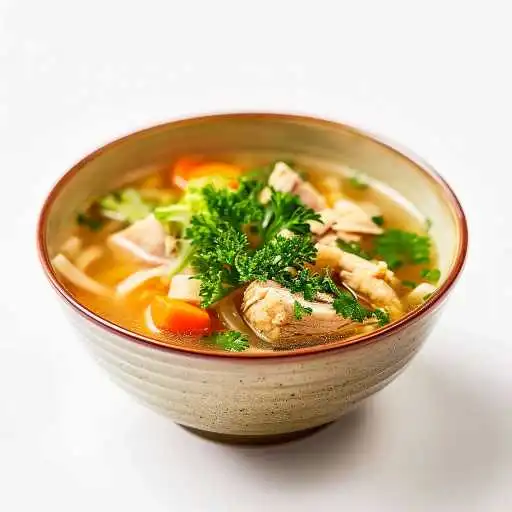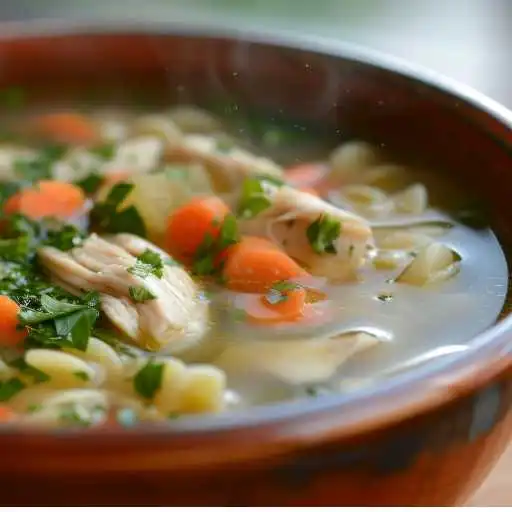Low Sodium Chicken Soup: 5 Tips for Delicious & Healthy Comfort
Picture this: a chilly evening, a warm bowl of low sodium chicken soup cradled in your hands, its fragrant steam rising to meet you. That feeling of soothing comfort, a memory etched deep within us, goes beyond mere nourishment. But what if you’re watching your sodium intake? Does that mean relinquishing this beloved comfort food? Absolutely not! This comprehensive guide reveals the culinary secrets to crafting incredibly flavorful low sodium chicken soup, demonstrating that healthy eating can be both delectable and profoundly satisfying. A steaming bowl of low sodium chicken soup is the perfect remedy for a chilly evening, offering warmth, nourishment, and flavor without compromising your health.
Table of Contents
The Importance of Low Sodium Chicken Soup in a High-Sodium World


In today’s world, processed foods and restaurant meals often contain high levels of sodium. The American Heart Association (AHA) recommends limiting sodium intake to less than 2,300 milligrams (mg) a day—that’s about one teaspoon of table salt! Many Americans exceed the recommended daily sodium intake, which can lead to high blood pressure—a significant risk factor for heart disease, stroke, and kidney disease. That’s why incorporating low sodium options, like homemade low sodium chicken soup, into your diet is crucial for maintaining long-term health. Choosing low sodium chicken soup allows you to savor this comfort food guilt-free, knowing you’re nourishing your body without the excess sodium. It’s a proactive step towards better health without sacrificing enjoyment.
Mastering Low Sodium Chicken Soup: A Step-by-Step Culinary Journey
Preparing low sodium chicken soup is easier than you might think. By following these simple steps and understanding the nuances of flavor building, you can create a delicious and healthy soup that rivals any high-sodium version.
1. Choosing the Right Ingredients: The Foundation of Flavor
The foundation of any great low sodium chicken soup lies in the careful selection of ingredients. Opting for fresh, whole ingredients allows you to control the sodium content from the start. Here’s a breakdown of the essential components:
| Ingredient | Quantity | Notes |
|---|---|---|
| Boneless, Skinless Chicken Breasts | 1.5 lbs | Provides lean protein, the star of your low sodium chicken soup. |
| Low Sodium Chicken Broth | 6 cups | Crucial for controlling sodium; choose a brand with the lowest sodium content. |
| Carrots, chopped | 2 cups | Adds natural sweetness and vibrant color, enhancing the flavor profile of your low sodium soup. |
| Celery, chopped | 1 cup | Contributes a savory, aromatic note that complements the chicken and other vegetables. |
| Yellow Onion, chopped | 1 medium | Builds a foundational layer of flavor, adding depth to your low sodium chicken soup. |
| Garlic, minced | 4 cloves | Enhances the savory depth without adding sodium; a powerful flavor booster. |
| Fresh Herbs (Parsley, Thyme, Bay Leaf) | As desired | Adds complexity and freshness; choose your favorites or experiment with different combinations. |
| Black Peppercorns | 1 teaspoon | Offers a subtle heat and enhances the overall flavor profile of your low sodium soup. |
| Olive Oil | 1 tablespoon | Used for sautéing vegetables, adding a touch of richness without excess sodium. |
2. Building a Flavorful Base: The Art of Layering Aromatics
This step is essential for crafting a delicious low-sodium chicken soup. In a large pot or Dutch oven, warm the olive oil over medium heat. Add the chopped onions, carrots, and celery, and sauté gently for 5–7 minutes, until they are softened but not browned. This process, known as sweating, allows the vegetables to release their natural sweetness and aromatic compounds, building a complex flavor base for your low sodium soup. Avoid browning the vegetables, as this can introduce bitterness.
3. Simmering for Success: Extracting Maximum Flavor
After the vegetables have softened, add the chicken breasts, low-sodium chicken broth, fresh herbs, and peppercorns to the pot. Slowly bring the mixture to a gentle simmer over medium-low heat. Avoid a vigorous boil, as it can cloud the broth and toughen the chicken. Simmer gently, uncovered, for about 1-1.5 hours, or until the chicken is cooked through and the flavors have melded beautifully. Skim off any foam or impurities that rise to the surface during simmering to ensure a clear and flavorful broth.
4. Seasoning Strategically: Enhancing Flavor without Sodium
Once the chicken is fully cooked, take it out of the pot and shred it using two forks. Add the shredded chicken back to the pot. Taste the soup and adjust the seasoning as needed, enhancing the flavors with fresh herbs, black pepper, or a splash of lemon juice for brightness. Avoid adding salt. The natural flavors of the chicken, vegetables, and herbs should provide ample depth and complexity without the need for added sodium.
5. Crafting Homemade Low Sodium Chicken Broth: Ultimate Control (Optional)
For ultimate control over sodium content, consider making your own low sodium chicken broth. It’s simpler than you might think and adds another layer of flavor to your soup.
- Gather your ingredients: Use leftover chicken carcasses, bones, or skin, along with vegetable scraps like onion peels, carrot tops, and celery leaves.
- Roast the bones (optional): Roasting the bones in a preheated oven at 400°F (200°C) for about 30 minutes enhances their flavor and adds depth to the broth.
- Simmer the ingredients: Place the roasted bones and vegetable scraps in a large pot, cover with water, and bring to a gentle simmer. Simmer for at least 4 hours, or up to 12 hours for maximum flavor extraction.
- Strain and store: Pour the broth through a fine-mesh sieve or cheesecloth to remove any solids, leaving you with a smooth, clear liquid. Once strained, transfer the broth to airtight containers. Store it in the refrigerator for up to 5 days, or freeze it for extended storage.
Creative Variations: Expanding Your Low Sodium Soup Repertoire
Once you’ve mastered the basic low sodium chicken soup recipe, feel free to experiment with different flavors and ingredients. Here are a few ideas to inspire you:
- Low Sodium Chicken and Vegetable Soup: Add a variety of colorful vegetables like diced zucchini, bell peppers, chopped spinach, or corn kernels to boost the nutritional value and add visual appeal.
- Low Sodium Chicken and White Bean Soup: Make sure to rinse canned beans thoroughly under cold water to remove excess sodium and improve their flavor.
- Low Sodium Chicken and Barley Soup: Add pearl barley or hulled barley for a heartier, more filling soup. Barley adds a nutty flavor and a chewy texture that complements the chicken and vegetables.
- Low Sodium Chicken and Wild Rice Soup: Wild rice adds a unique earthy flavor and texture to your soup. Combine it with brown rice for a balanced blend of flavors and textures.
- Low Sodium Asian-Inspired Chicken Soup: Infuse your soup with Asian flavors by adding ginger, garlic, soy sauce (low sodium), and rice noodles. Top your soup with freshly chopped cilantro and a squeeze of lime juice for a burst of vibrant flavor.
FAQ: Your Low Sodium Chicken Soup Questions Answered
Here are answers to some frequently asked questions about low sodium chicken soup:
- Q: Can I use canned vegetables in low-sodium chicken soup? A: Yes, you can use canned vegetables, but choose low-sodium or no-salt-added varieties to keep the sodium content in check. Rinse the canned vegetables thoroughly before adding them to your soup to remove any excess sodium.
- How can I store low-sodium chicken soup? Store any leftover low-sodium chicken soup in an airtight container in the refrigerator for up to 4 days. For extended storage, freeze the soup for up to 3 months.
- Is low-sodium chicken soup beneficial when I have a cold? A: Yes, low sodium chicken soup can be soothing and hydrating when you have a cold. The warm broth can help clear nasal congestion, and the nutrients in the soup can support your immune system.
- Can I add noodles or rice to my low-sodium chicken soup? A: Yes, you can add noodles or rice to your low sodium chicken soup, but be mindful of the sodium content of these additions. Choose whole wheat noodles or brown rice for added nutritional value. If using packaged noodles or rice, check the label for sodium content and adjust your recipe accordingly.
Conclusion: Embrace the Flavor of Healthy Comfort
Low sodium chicken soup is more than just a comforting meal; it’s a testament to the fact that healthy eating doesn’t have to mean sacrificing flavor. By understanding the principles of flavor building and utilizing fresh, wholesome ingredients, you can create a delicious and nutritious soup that nourishes your body and soul. Experiment with different variations, explore new flavor combinations, and discover the joy of creating your perfect bowl of low sodium chicken soup. Share your culinary creations and inspire others to embrace the flavor of healthy comfort. What are your favorite low sodium chicken soup variations? Let us know! Happy cooking!

